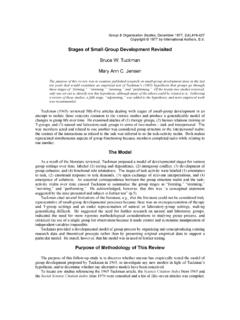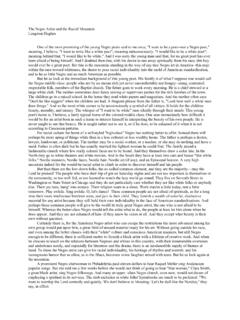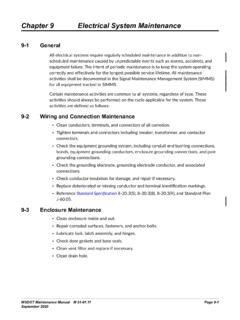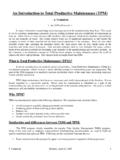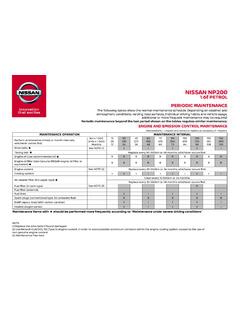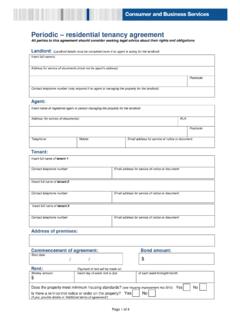Transcription of For Financial Reporting Purposes
1 FIXED ASSET GUIDE For Financial Reporting Purposes CAFR Group, State Auditor s Office June 24, 2008 FIXED ASSET GUIDE CAFR Group June 24, 2008 Page 2 of 13 Objective To assist with the accounting for and Reporting of the State's assets including new building construction and improvements in conformity with Generally Accepted Accounting Principles and in principal with Governmental Accounting Standards Board Statement 34. Policy Governmental Accounting Standards Board (GASB) Statement 34 requires that all capital assets be reported in the government wide balance sheet net of accumulated depreciation if applicable. Each agency is responsible for Reporting accurate, complete, and timely capital asset information to the State Auditor s Office (SAO) annually. The CAFR Group of SAO is responsible for compiling the capital asset information from agencies for inclusion in the State's Comprehensive Annual Financial Report.
2 Capital Asset Definitions and Guidelines Capital assets are tangible and intangible assets acquired for use in operations that will benefit more than a single fiscal period. Typical examples are land, improvements to land, easements, water rights, buildings, building improvements, vehicles, machinery, equipment, works of art and historical treasures, infrastructure, and various intangible assets. (Land associated with infrastructure should be reported as land rather than as part of the cost of the related infrastructure asset). A capitalized asset is a capital asset that has a value equal to or greater than the capitalization threshold established for that asset type. Capitalized assets are reported for Financial Reporting Purposes . Capital Asset Classification The State has invested in a wide variety of capital assets used in State operations.
3 These assets are broadly classified as follows: Land/Land Improvements/Easements Buildings/Building Improvements Leasehold Improvements Equipment Other Tangible and Intangible Assets Infrastructure Assets Under Construction Capital Leases Works of Art/Historical Treasures FIXED ASSET GUIDE CAFR Group June 24, 2008 Page 3 of 13 Asset Class The asset class is used to organize capital assets in the broad classifications detailed above. An essential function of the asset class is to establish a link between the asset master record and the related posting to the accounting general ledger. Therefore, assets purchased, constructed or donated that meet or exceed the capitalization threshold or minimum Reporting requirements must be uniformly classified, utilizing the existing Asset Class structure. Each asset class is further detailed into class codes.
4 The class code breaks the asset class into groups of similar items. The class code also contains the recommended estimated useful life (expressed in years) for the group of assets. Capital Asset Acquisition Cost Capital assets shall be recorded and reported at their historical costs. Historical cost includes the vendor s invoice (less the value of any trade in), initial installation cost (excluding in house labor), modifications, attachments, accessories or apparatus necessary to make the asset usable and render it into service. Historical costs also include ancillary charges such as freight and transportation charges, site preparation costs and professional fees. The costs of capital assets for governmental activities do not include capitalized interest. Interest, however, is capitalized on assets that are constructed for an agency s enterprise fund or otherwise produced for an enterprise fund s own use (including assets constructed or produced for the enterprise by others for which deposits or progress payments have been made), and assets intended for sale or lease that are constructed or otherwise produced as discrete projects (for example, ships or real estate developments).
5 PLEASE NOTE: The book value of assets recorded at historical costs should never be increased to reflect appraised value, insurance value, replacement cost, etc. When the sale is between state entities, the selling agency s historical cost of the asset and the accumulated depreciation will carry in WOLFS to the agency buying/receiving the asset. A gain or loss is not recognized. Capitalization Threshold Standard capitalization thresholds for capitalizing assets for each major class of assets are as follows: Asset Class Threshold Land Capitalize All Land Improvements $ 500 Easements Capitalize All Buildings/Building Improvements $ 500 Leasehold Improvements $ 500 Vehicles $ 500 Equipment $ 500 Other Tangible and Intangible Assets $ 500 Infrastructure $ 1,500,000 Capital Leases $ 500 Asset under Construction Not Applicable Works of Art/Historical Treasures Exemption FIXED ASSET GUIDE CAFR Group June 24, 2008 Page 4 of 13 Capital Asset Donations: GASB Statement No.
6 33, Accounting and Financial Reporting for Non Exchange Transactions, defines a donation as a voluntary non exchange transaction entered into willingly by two or more parties. Both parties may be governments, such as the Federal Government, another state, a county or municipality, or one party may be a nongovernmental entity, including an individual. PLEASE NOTE: A voluntary contribution of resources between State agencies is not a donation. The timing of recognition of the asset and related revenue is outlined as follows: When an asset has been received and the eligibility requirements to receive the asset have been met, capital assets are debited and revenue is credited in the fund Financial statements of an enterprise fund and the government wide Financial statements for a governmental fund. When an asset has been received but the eligibility requirements to receive the asset have not been met, capital assets are debited and deferred revenue is credited in the fund Financial statements of an enterprise fund and the government wide Financial statements for a governmental fund.
7 Appraisal of Assets (Gifts and Donations) Donated property must be recorded at its estimated fair market value on the date of acquisition, using a reasonable market study. The method used to appraise the value computed for gifts and donations should be based on a reasonable assessment. This method must be fully documented and maintained on file to support the value. Capital Asset Categories Land Land is defined as the surface or crust of the earth, which may be used to support structures or grow crops, grass, shrubs, and trees. Land is characterized as having an inexhaustible life. All expenditures made to acquire land and to ready it for its intended use should be considered as part of the land cost Examples of expenditures to be capitalized as land: Purchase price or, if donated, fair market value at time of donation Commissions Professional fees (title searches, architect, legal, engineering, appraisal, surveying, environmental assessments, etc.)
8 Permanent landscaping such as land clearing, excavation, fill, grading, drainage (includes movement of earth in preparation for water impoundment) Demolition of existing buildings and improvements (less salvage) Removal, relocation, or reconstruction of property of others on the land so that the land may be used differently (railroad, telephone and power lines) Interest on mortgages accrued at date of purchase Accrued and unpaid taxes at date of purchase Other costs incurred in acquiring the land FIXED ASSET GUIDE CAFR Group June 24, 2008 Page 5 of 13 Water wells (includes initial cost for drilling, the pump and its casing) Right of way. Land Improvements Land improvements are defined as attachments to the land that have limited lives and therefore are recorded separately and are depreciable. Examples of expenditures to be capitalized as land improvements: Fencing and gates Landscaping of temporary nature Parking lots/driveways/parking barriers/roadway Outside sprinkler systems Recreation areas & athletic fields (including bleachers) Golf course Paths and trails Septic systems Swimming pools, tennis courts Fountains Plazas, pavilions Retaining walls Lighting systems Water impoundment structures or attachments (dam, liner, other water control structures) Buildings and Building Improvements A building is defined as a structure that is permanently attached to the land, has a roof, is partially or completely enclosed by walls, and is not intended to be mobile.
9 Building improvements are defined as capital events that increase the value of a building, materially extend the useful life of a building, or both. A building improvement should be capitalized as a sub asset of the building and recorded as an addition of value to the existing building if the expenditure for the improvement is at the capitalization threshold and the expenditure increases the life or value of the building by 25 percent of the original life period or cost. Examples of expenditures to be capitalized as buildings PURCHASED BUILDINGS Original purchase price Expenses for remodeling, reconditioning or altering a purchased building to make it ready to use for the purpose for which it was acquired Environmental compliance ( , asbestos abatement) Professional fees (sales commission, legal, architect, inspection, appraisal, title search, etc.)
10 Payment of unpaid or accrued taxes on the building at the date of purchase FIXED ASSET GUIDE CAFR Group June 24, 2008 Page 6 of 13 Cancellation or buyout of existing leases on the building Other costs required to place or render the asset into operation CONSTRUCTED BUILDINGS Completed project costs Interest accrued during construction for enterprise type activities Cost of excavation or grading or filling of land for a specific building Expenses incurred for the preparation of plans, specifications, blueprints, etc. Cost of building permits Professional fees (architect, engineer, management fees for design and supervision, legal) Note: Architect fees are expensed if a decision is made to not proceed with the construction of the building. Costs of temporary buildings used during and for the construction Unanticipated costs such as rock blasting, piling, or relocation of the channel of an underground stream Examples of Expenditures to be Capitalized as Building Improvements: Note: For a replacement to be capitalized, it must be a part of a major repair or rehabilitation project that increases the value and/or useful life of the building (such as renovation of a student center) and meets the capitalization threshold.





